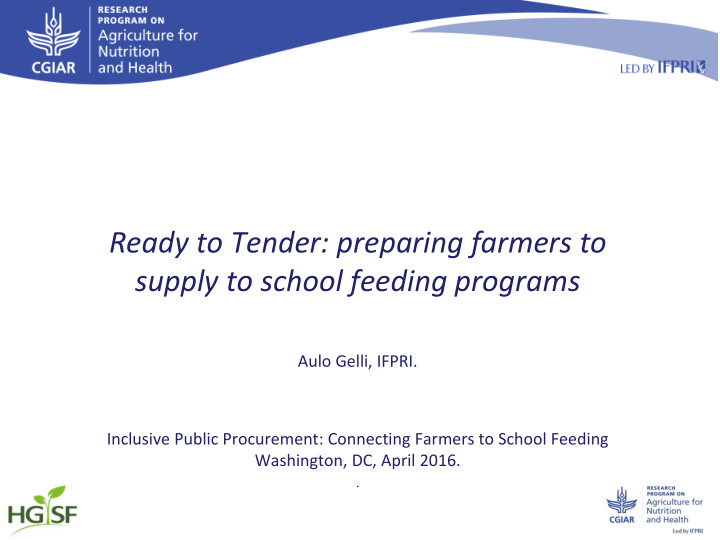



Ready to Tender: preparing farmers to supply to school feeding programs Aulo Gelli, IFPRI. Inclusive Public Procurement: Connecting Farmers to School Feeding Washington, DC, April 2016. .
Providing farmers with market information • Develop menu plans as a basis for market information, procurement plans and schedules (school, district, regional, national levels) • At a minimum, for each school, identify and publish requirements for school feeding, including – Food quantities – Food quality – Price – Timing – Origin/sourcing option – Payment schedule
Talking points 1. School feeding as a strategy with different objectives 2. Demand for goods and services as a market opportunity for producers and businesses 3. Supply chain framework can be used to identify opportunities and challenges for different implementation models 4. Example in Ghana
School feeding: A strategy with multiple objectives? Education Rigorous evidence Nutrition and health School feeding Rigorous evidence Agriculture ? Rigorous evidence SME Simple idea, but programmes can development be quite complex! -Optimisation problem: Managing complexity and trade-offs across objectives is not straightforward…
Market opportunity • Demand for goods and services for producers and value chain actors – On average ~ $50 per child per year* – Approximately ~ 25 kg of food per child per year* – Demand is stable throughout the school year • Maize: On average, at current scale demand equivalent to ~10% of production and food supply • Maximum scale-up demand potential equivalent to ~40% of production and food supply (n=32 countries across sSA) * (Gelli & Daryanani, 2013)
Supply chain goals and objectives Timely, uninterrupted supply of quality food with links to small holder farmers Steady supply: Quality assurance: Small-holder access: Develop resilient supply Process standards applied Small holder farmers chain system across supply chains participate in supply chain -Procurement system -Quality standards are -Improved production capacity allows explicit management developed e.g. Farmer field schools, of seasonality, scale and e.g. Nutrition and food safety inputs… geographical context standards developed -Improved awareness of school e.g. Guidelines for different -Quality standards are feeding market purchasing models and monitored e.g. Sensitisation campaigns different commodities e.g. testing for aflatoxin, (including perishables) menu composition is monitored Community ownership Transparency of financial flows Sustainability
Seasonal calendar in Ghana Term 1 School term 2 School term 3 School
Menu planning • Optimise use of budget($/child) – Nutrition content – Healthy and culturally acceptable foods – In-season and relevant to the small holder harvest in the vicinity of the schools – Food safety • Example: – Identifying nutrition gaps in Ghana – Opportunity to utilize under-utilized foods – e.g. for vitamin A: orange flesh sweet potatoes, fresh palm oil etc… (Parish & Gelli, 2015)
www.hgsf-global.org
Providing farmers with market information • Develop menu plans as a basis for market information, procurement plans and schedules (school, district, regional, national levels) • At a minimum, for each school, identify and publish requirements for school feeding, including – Food quantities – Food quality – Price – Timing – Origin/sourcing option – Payment schedule
Randomised trial in Ghana • Theory-based mixed-method impact evaluation of national programme – 116 schools, randomised • 29 SF standard • 29 HGSF+ pilot • 58 no school feeding (controls, get SF after year 2) • 3 year study in partnership with Government of Ghana, University of Ghana, Partnership for Child Development and IFPRI • Study outcomes include child health and nutritional status, school participation and learning, and smallholder farmer income • Intermediate outcomes along the agriculture and nutrition pathways were also measured • Endline survey just completed!
Thank you!
Recommend
More recommend